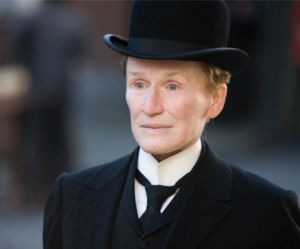Close to the vest
 I’ve long had a weird obsession with Glenn Close. Albert Nobbs is the best work she’s done on film in 20 years. Here’s my review, also found here.
I’ve long had a weird obsession with Glenn Close. Albert Nobbs is the best work she’s done on film in 20 years. Here’s my review, also found here.
A few weeks ago, I pointed out that 2011 was a great year for queer cinema because of Heartbeats, Weekend, and most recently Pariah. And there’s a fourth film, which is now just opening in San Diego:Albert Nobbs, a period drama about what we would now call transgenderism starring Glenn Close in her best performance in nearly a quarter century. Close not only stars in the film, reprising a role she performed Off-Broadway in 1982, but she also co-wrote the script, the original song and she produced the movie. If you’re trying to see all of the Oscar bait movies before the big show in March, Albert Nobbs should be at the top of your list.
In Victorian London, the titular character (Close) is a fastidious, formal, and, according to those who know him, quite odd butler in a hotel. No one Albert works with is aware that he is actually a woman who straps down her breasts and never appears remotely undressed in front of another person. Albert is not a wink-wink man pretending to be a woman, à la Yentl or Victor/Victoria. When the one person who knows what he is hiding asks his “real” name, he says, “Albert.”
Albert is who he is, and the problem is that he is both lonely and trapped by his secret. Then he meets Hubert Page (McTeer, brilliantly wise and tough), a house painter who is hired to do some work around the hotel. When Albert is told that Hubert needs to sleep in Albert’s room, Albert is terrified. And rightfully: Hubert sees Albert undressing. But Hubert, it turns out, has the same secret. Except that Hubert is successfully living as a married man, working for himself, and is happy. Albert sees hope and possibility and tries to do what Hubert has, and key to this is wooing a maid in the hotel, the young and shallow Helen (Mia Wasikowska).
The smart script is without cliché or pedantic explanations of gender, and it is economically handled by the director Rodrigo Garcia. My only qualm is that it is perhaps too tidy, but it is a Victorian tragedy, and its tidiness fulfills its genre expectations without being either gothic or exploitative.
However, the script and the direction are easy not to even notice because Close’s performance is so entrancing. In the 1980s, when only Meryl Streep rivaled her as the great American actress, Close was often so strong and haughty as to be called mannish. This time, playing a woman who is a man, Close uses that masculinity even more skillfully, almost like a hot potato: It’s there, it’s not – will he be found out? But Albert is not only trying to convince the world that he is who he wants Albert to be. He is also nervous, amused, eager and it seems, in love.
MOVIE REVIEW
Albert Nobbs
Directed by Rodrigo Garcia
Written by Glenn Close and John Banville
Starring Glenn Close, Janet McTeer and Mia Wasikowska
Rated R
At Landmark Hillcrest


